Bob Hope Show
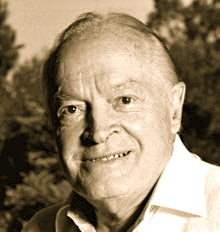
Strictly GI (1943) Bob Hope USO Studio Show Video Recording
Recording of a USO Command Performance show for record distribution to US troops. Features: Bob Hope as host, Betty Hutton sings ‘He Says Murder, He Says,’ Lana Turner grills a porterhouse steak and Judy Garland sings ‘Somewhere Over The Rainbow.’
Bob Hope, KBE, KCSG, KSS, born Leslie Townes Hope (May 29, 1903 – July 27, 2003), was an English-born American comedian, vaudevillian, actor, singer, dancer, author, and athlete who appeared on Broadway, in vaudeville, movies, television, and on the radio. He was noted for his numerous United Service Organizations (USO) shows entertaining American military personnel—he made 57 tours for the USO between 1942 and 1991. Throughout his long career, he was honored for this work. In 1996, the U.S. Congress declared him the “first and only honorary veteran of the U.S. armed forces.”
Over a career spanning 60 years (1934 to 1994), Hope appeared in over 70 films and shorts, including a series of “Road” movies co-starring Bing Crosbyand Dorothy Lamour. In addition to hosting the Academy Awards fourteen times, he appeared in many stage productions and television roles, and was the author of fourteen books. He participated in the sports of golf and boxing, and owned a small stake in his hometown baseball team, the Cleveland Indians. He was married to his wife, fellow performer Dolores Hope (née DeFina), for 69 years.
Early years
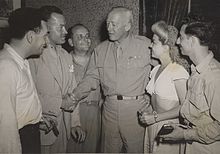 Writer Hal Block (l.) and Hope meetGeorge Patton in Sicily during World War II
Writer Hal Block (l.) and Hope meetGeorge Patton in Sicily during World War II
Hope was born in Eltham, London, UK, the fifth of seven sons. His English father, William Henry Hope, was a stonemason from Weston-super-Mare, Somerset, and his Welsh mother, Avis Townes, was a light opera singer from Barry who later worked as a cleaning woman. She married William Hope in April 1891 and the couple lived at 12 Greenwood Street in the town, then moved to Whitehall and St George in Bristol. In 1908 the family emigrated to the United States aboard the SS Philadelphia, and passed inspection at Ellis Island on March 30, 1908, before moving to Cleveland, Ohio.
From the age of 12, Hope earned pocket money by busking (frequently on the streetcar to Luna Park), singing, dancing, and performing comedy patter. He entered many dancing and amateur talent contests (as Lester Hope), and won a prize in 1915 for his impersonation of Charlie Chaplin. For a time Hope attended the Boys Industrial School in Lancaster, Ohio. As an adult, Hope donated sizable sums of money to the institution.
Hope worked as a butcher’s assistant and a lineman in his teens and early twenties. Deciding to try a show business career, he and his girlfriend, Millie Rosequist, signed up for dance lessons. Encouraged after they performed in a three-day engagement at a club, Hope then formed a partnership with Lloyd Durbin, a fellow pupil from the dance school. Silent film comedian Fatty Arbuckle saw them perform in 1925 and obtained them steady work with a touring troupe called Hurley’s Jolly Follies. Within a year, Hope had formed an act called the Dancemedians with George Byrne and the Hilton Sisters, conjoined twins who performed a tap dancing routine in the vaudeville circuit. Hope and Byrne had an act as a pair of Siamese twins as well, and danced and sang while wearing blackface, before friends advised Hope that he was funnier as himself. In 1929, he changed his first name to “Bob”. In one version of the story, he named himself after racecar driver Bob Burman. In another, he said he chose Bob because he wanted a name with a friendly “Hiya, fellas!” sound to it. After five years on the vaudeville circuit, Hope was surprised and humbled when he failed a 1930 screen test for the French film production company Pathé at Culver City, California.
Career
In the early days, Hope’s career included appearances on stage in Vaudeville shows and Broadway productions. He began performing on the radio in 1934 and switched to television when that medium became popular in the 1950s. He began doing regular TV specials in 1954, and hosted the Academy Awards fourteen times in the period from 1941 to 1978. Overlapping with this was his movie career, spanning the years 1934 to 1972, and his USO tours, which he did from 1942 to 1988.
Film – Bob Hope filmography and Bob Hope short subjects
Hope signed a contract for six short films with Educational Pictures of New York. The first was a comedy, Going Spanish (1934). He was not happy with the film, and told Walter Winchell, “When they catch John Dillinger, they’re going to make him sit through it twice.” Educational dropped his contract, but he soon signed with Warner Brothers. He made movies during the day and performed Broadway shows in the evenings.
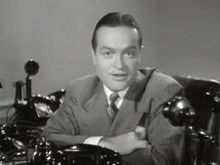 Bob Hope in The Ghost Breakers trailer (1940)
Bob Hope in The Ghost Breakers trailer (1940)
Hope moved to Hollywood when Paramount Pictures signed him for the 1938 film The Big Broadcast of 1938, also starring W. C. Fields. The song “Thanks for the Memory“, which later became his trademark, was introduced in this film as a duet with Shirley Ross as accompanied by Shep Fields and his orchestra. The sentimental, fluid nature of the music allowed Hope’s writers (he depended heavily upon joke writers throughout his career) to later create variations of the song to fit specific circumstances, such as bidding farewell to troops while on tour.
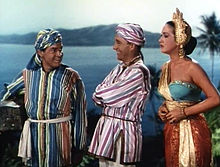 Bob Hope, Bing Crosby, and Dorothy Lamour in Road to Bali (1952)
Bob Hope, Bing Crosby, and Dorothy Lamour in Road to Bali (1952)
As a movie star, he was best known for comedies like My Favorite Brunette and the highly successful “Road” movies in which he starred with Bing Crosby and Dorothy Lamour. The series consists of seven films made between 1940 and 1962. Hope had seen Lamour as a nightclub singer in New York, and invited her to work on his United Service Organizations (USO) tours. Lamour sometimes arrived for filming prepared with her lines, only to be baffled by completely re-written scripts or ad-lib dialogue between Hope and Crosby. Hope and Lamour were lifelong friends, and she remains the actress most associated with his film career. Hope made movies with dozens of other leading ladies, including Katharine Hepburn, Hedy Lamarr, Lucille Ball, Rosemary Clooney, Jane Russell and Elke Sommer.
Hope teamed with Crosby for the “Road” pictures and countless stage, radio, and television appearances over the decades, from their first meeting in 1932 until Crosby’s death in 1977. The two invested together in oil leases and other business ventures, but did not see each other socially.
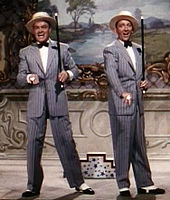 Bob Hope and Bing Crosby sing and dance during “Chicago Style” in Road to Bali (1952)
Bob Hope and Bing Crosby sing and dance during “Chicago Style” in Road to Bali (1952)
After the release of Road to Singapore (1940), Hope’s screen career took off, and he had a long and successful career in the movies. After an 11-year hiatus, Hope and Crosby teamed up for the last Road movie, The Road to Hong Kong (1962), starring 28-year old Joan Collins in place of Lamour, who Hope and Crosby thought was too old for the part. They had planned one more movie together in 1977, The Road to the Fountain of Youth. Filming was postponed when Crosby was injured in a fall, and the production was cancelled when he suddenly died of heart failure that October.
Hope starred in 54 theatrical features between 1938 and 1972, as well as cameos and short films. Most of Hope’s later movies failed to match the success of his 1940s efforts. He was disappointed with his appearance in Cancel My Reservation (1972), his last film, and the movie was poorly received by critics and filmgoers.
Hope was host of the Academy Awards ceremony fourteen times between 1939 and 1977. His feigned desire for an Academy Award became part of his act. Although he was never nominated for an Oscar, the Academy of Motion Picture Arts and Sciences honored him with four honorary awards, and in 1960, the Jean Hersholt Humanitarian Award. While introducing the 1968 telecast, he quipped, “Welcome to the Academy Awards, or, as it’s known at my house, m Passover.”
Bob Hope television appearances
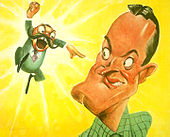 Jerry Colonna and Bob Hope as caricatured by Sam Berman for NBC’s 1947 promotional book
Jerry Colonna and Bob Hope as caricatured by Sam Berman for NBC’s 1947 promotional book
Hope’s career in broadcasting began on radio in 1934. His first regular series for NBC Radio was the Woodbury Soap Hour in 1937, a 26-week contract. A year later, The Pepsodent Show Starring Bob Hope began, and Hope signed a ten-year contract with the show’s sponsor, Lever Brothers. The show became the top radio program in the country. Regulars on the series included Jerry Colonna and Barbara Jo Allen as spinster Vera Vague. Hope continued his lucrative career in radio through to the 1950’s, when radio’s popularity was overshadowed by television.
 Hope (right) with his brother Jack Hope (seated), who produced his early 1950’s show. Standing between them is comedian Jack Benny.
Hope (right) with his brother Jack Hope (seated), who produced his early 1950’s show. Standing between them is comedian Jack Benny.
Hope did many specials for the NBC television network in the following decades, beginning in April 1950. He was one of the first people to use cue cards. The shows were often sponsored by General Motors (1955–1961), Chrysler (1963–73), and Texaco (1975–1985). Hope’s Christmas specials were popular favorites and often featured a performance of “Silver Bells” (from his 1951 film The Lemon Drop Kid) done as a duet with an often much younger female guest star (such as Olivia Newton-John, Barbara Eden, and Brooke Shields), or with his wife Dolores, with whom he dueted on two specials. Hope’s 1970 and 1971 Christmas specials for NBC—filmed in Vietnam in front of military audiences at the height of the war—are on the list of the Top 46 U.S. network prime-time telecasts. Both were seen by more than 60 per cent of the U.S. households watching television.
 Hope with James Garner (1961)
Hope with James Garner (1961)
In 1992, Hope made a guest appearance as himself onThe Simpsons, in the episode “Lisa the Beauty Queen” (season 4, episode 4). Towards the end of his career, eye problems left him unable to read his cue cards. His 90th birthday television celebration in May 1993, Bob Hope: The First 90 Years, won an Emmy Award for Outstanding Variety, Music Or Comedy Special. In October 1996 Hope announced that he was ending his 60-year contract with NBC, joking that he “decided to become a free agent.” His final television special, Laughing with the Presidents, was broadcast in November 1996, with host Tony Danza helping him present a personal retrospective of presidents of the United States known to the comedian. The special received poor reviews. Following a brief appearance at the 50th Primetime Emmy Awards in 1997, Hope’s last TV appearance was in a 1997 K-Mart commercial directed by Penny Marshall.
 Hope entertains soldiers during World War II
Hope entertains soldiers during World War II
While aboard the RMS Queen Mary when World War II began in September 1939, Hope volunteered to perform a special show for the passengers, during which he sang “Thanks for the Memory” with rewritten lyrics. He performed his first USO show on May 6, 1941, at March Field, California, and continued to travel and entertain troops for the rest of World War II, later during the Korean War, the Vietnam War, the third phase of the Lebanon Civil War, the latter years of the Iran–Iraq War, and the 1990–1991 Persian Gulf War. His USO career lasted half a century, during which he headlined 57 tours. He had a deep respect for the men and women who served in the military, and this was reflected in his willingness to go anywhere in order to entertain them. During the Vietnam War, Hope had trouble convincing some performers to join him on tour. Anti-war sentiment was high, and Hope’s pro-war stance made him a target of criticism. Some shows were drowned out by boos and others were listened to in silence. The tours were funded by the United States Department of Defense, his television sponsors, and by NBC, the network which broadcast the television specials that were created after each tour. Many people considered him as an enabler of the war and a member of the system that made it possible.
 Hope at Lackland Air Force Base, 1990
Hope at Lackland Air Force Base, 1990
Hope recruited his own family members for USO travel. His wife, Dolores, sang from atop an armored vehicle during the Desert Storm tour, and his granddaughter, Miranda, appeared alongside Hope on an aircraft carrier in the Indian Ocean. Of Hope’s USO shows in World War II, writer John Steinbeck, who was then working as a war correspondent, wrote in 1943:
“When the time for recognition of service to the nation in wartime comes to be considered, Bob Hope should be high on the list. This man drives himself and is driven. It is impossible to see how he can do so much, can cover so much ground, can work so hard, and can be so effective. He works month after month at a pace that would kill most people.”
For his service to his country through the USO, he was awarded the Sylvanus Thayer Award by the United States Military Academy at West Point in 1968. A 1997 act of Congress signed by President Bill Clinton named Hope an “Honorary Veteran.” He remarked, “I’ve been given many awards in my lifetime — but to be numbered among the men and women I admire most — is the greatest honor I have ever received.” In homage to Hope, Stephen Colbert carried a golf club on stage each night during his own week of USO performances, which were taped for his TV show, The Colbert Report, during the 2009 season.
Theater
Hope’s first Broadway appearances, in 1927’s The Sidewalks of New York and 1928’s Ups-a-Daisy, were minor walk-on parts. He returned to Broadway in 1933 to star as Huckleberry Haines in the Jerome Kern / Dorothy Fields musical Roberta. Stints in the musicals Say When, the 1936 Ziegfeld Follies (with Fanny Brice), and Red, Hot and Blue with Ethel Merman and Jimmy Durante followed. Hope reprised his role as Huck Haines in a 1958 production of Roberta at The Muny Theater in Forest Park, St. Louis, Missouri.
Hope rescued Eltham Little Theatre from closure by providing funds to buy the property. He continued his interest and support and regularly visited when in London. The Theatre was renamed in his honor in 1982.
Critical Reception
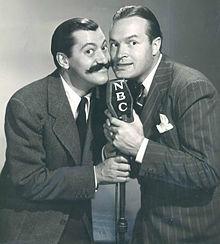 With sidekick Jerry Colonna in 1940
With sidekick Jerry Colonna in 1940
Hope was praised for his comedic timing, specializing in one-liners and rapid-fire delivery of jokes. His style of delivery of self-deprecating jokes, first building himself up and then tearing himself down, was unique. Working tirelessly, he performed hundreds of times per year. Early films such as The Cat and the Canary (1939) and The Paleface (1948) were financially successful and were praised by critics, and by the mid-1940s, with his radio program getting good ratings as well, he became one of the most popular entertainers in the United States. When Paramount threatened to stop production of the Road pictures in 1945, they received 75,000 letters in protest. He had no faith in his skills as a dramatic actor, and his performances of that type were not as well received. Hope had been a leader in the radio genre until the late 1940’s, but as his ratings began to slip, he switched to television in the 1950s, an early pioneer of that medium. He published several books—written with ghostwriters—about his wartime experiences.
Although he made an effort to keep his material up-to-date, he never adapted his comic persona or his routines to any great degree. By the 1970’s his popularity was beginning to wane with soldiers and with the movie-going public. However, he continued doing USO tours into the 1980’s in spite of being considered a promoter of the military–industrial complex, as he thought it was a patriotic thing to do, and he continued to appear on television into the 1990’s. Nancy Reagan called him “America’s most honored citizen and our favorite clown.”
Sports
Hope had a brief career as a boxer in 1919 fighting under the name Packy East. He had three wins and one loss, and participated in a few staged charity bouts later in life.
 Bob Hope, a golf fan, putting a golf ball into an ashtray held by President Richard Nixon in the Oval Office in 1973
Bob Hope, a golf fan, putting a golf ball into an ashtray held by President Richard Nixon in the Oval Office in 1973
Hope was an avid golfer, playing in as many as 150 charity tournaments a year. Introduced to the game in the 1930s while performing in Winnipeg, he eventually played to a four handicap. His love for the game—and the humor he could find in it—made him a sought-after foursome member. He once remarked that President Dwight D. Eisenhower gave up golf for painting – “fewer strokes, you know.” “It’s wonderful how you can start out with three strangers in the morning, play 18 holes, and by the time the day is over you have three solid enemies,” he once said.
A golf club became an integral prop for Hope during the standup segments of his television specials and USO shows. In 1978, he putted against a then two-year-old Tiger Woods in a television appearance with James Stewart on The Mike Douglas Show.
The Bob Hope Classic, founded in 1960, made history in 1995 when Hope teed up for the opening round in a foursome which included Presidents Gerald Ford, George H.W. Bush, and Bill Clinton – the only time when three presidents played in the same golf foursome. Now known as the Humana Challenge, it was the only PGA TOUR tournament that took place over five rounds, until the 2012 tournament, when it was cut back to the conventional four rounds. Hope bought a small stake in the Cleveland Indians baseball team in 1946 and owned it for most of the rest of his life. He appeared on the June 3, 1963, cover of Sports Illustrated magazine wearing an Indians uniform, and sang a special version of “Thanks for the Memory” after the Indians’ last game at Cleveland Stadium. Hope bought a share of the Los Angeles Rams football team in 1947 with Bing Crosby and sold it in 1962. He would frequently use his television specials to promote the annual College Football All-America Team. The players would enter the stage one-by-one and introduce themselves, and Hope, often dressed in a football uniform, would give a one-liner about the player or his school.
Personal life – Marriages
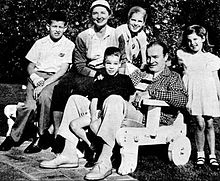 The Hope family. Back, from left: Tony, Dolores, and Linda. Front, from left: Kelly, Hope, and Nora
The Hope family. Back, from left: Tony, Dolores, and Linda. Front, from left: Kelly, Hope, and Nora
Hope’s first short-lived marriage was to his vaudeville partner, Grace Louise Troxell, whom he married in January 1933. In 1934, Hope married Dolores (DeFina) Reade, who had been one of his costars on Broadway in Roberta. They adopted four children at an adoption agency called The Cradle, inm Evanston, Illinois: Linda (1939), Tony (1940), Kelly (1946), and Nora (1946). From them he had several grandchildren, including Andrew, Miranda, and Zachary Hope. Tony (as Anthony J. Hope) served as a presidential appointee in the George H. W. Bush and Clinton administrations and in a variety of posts under Presidents Gerald Ford and Ronald Reagan.
Extramarital affairs
Hope had a reputation as a womanizer and continued to see other women in spite of his marriage. In 1949, while Hope was in Dallas on a publicity tour for his radio show, he met starlet Barbara Payton, a contract player at Universal Studios, who at the time was on her own public relations jaunt. Shortly thereafter, Hope set Payton up in an apartment in Hollywood. The arrangement soured as Hope was not able to satisfy Payton’s definition of generosity and her need for attention. Hope paid her off to end the affair quietly. Payton later revealed the affair in an article printed in July 1956 in Confidential. “Hope was … at times a mean-spirited individual with the ability to respond with a ruthless vengeance when sufficiently provoked.” His advisors counseled him to avoid further publicity by ignoring the Confidentialexposé. “Barbara’s … revelations caused a minor ripple … and then quickly sank without causing any appreciable damage to Bob Hope’s legendary career.” According to Arthur Marx‘s Hope biography, The Secret Life of Bob Hope, Hope’s subsequent long-term affair with actress Marilyn Maxwell was so open that the Hollywood community routinely referred to her as “Mrs. Bob Hope.”
Activism
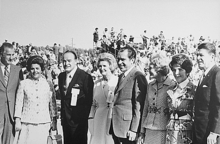 From left to right: Spiro and Judy Agnew, Bob and Dolores Hope, Richard and Pat Nixon, Nancy and Ronald Reagan during a campaign stop for the Nixon-Agnew ticket in California, 1971
From left to right: Spiro and Judy Agnew, Bob and Dolores Hope, Richard and Pat Nixon, Nancy and Ronald Reagan during a campaign stop for the Nixon-Agnew ticket in California, 1971
Hope served as an active honorary chairman on the board of Fight for Sight. He hosted their Lights On telecast in 1960 and donated $100,000 to establish the Bob Hope Fight for Sight Fund. He recruited numerous top celebrities for the annual “Lights On” fundraiser; as an example, he hosted Joe Frazier, Yvonne DeCarlo, and Sergio Franchi as headliners for the show at Philharmonic Hall in Milwaukee on April 25, 1971.


